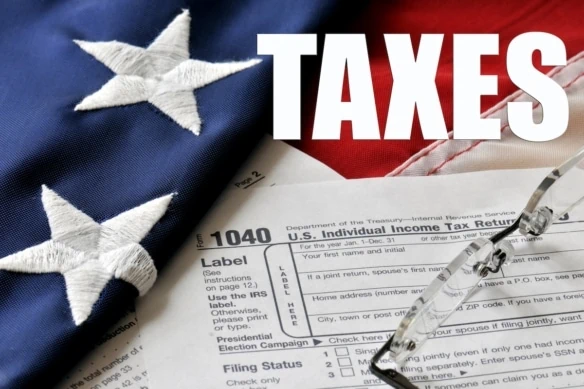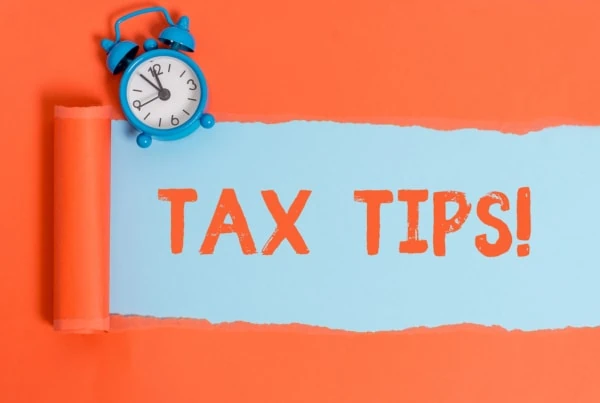“Taxes are what we pay for civilized society,” according to the late U.S. Supreme Court Justice Oliver Wendell Holmes, Jr. That may be true … but we all still hate paying them! Particularly when it feels like some people aren’t paying their fair share, we’re not getting much for our tax dollars, and Congress just wants more of our money.
But maybe our tax system isn’t so rotten afterall. If you dig down into some of the tax statistics and other data available, you might find that taxes are more reasonable and equitable than you imagined.
Take a look at the collection of federal income tax statistics and facts I’ve compiled for you below. Some of them are fascinating (at least I think so) … and perhaps eye-opening. Do they make U.S. tax policy easier to understand? Do they make you feel better about your current tax burden? Do they make taxes seem fairer? You be the judge!
Featured Financial Products
Related: When Are Taxes Due [Tax Deadlines for the Entire Year]
General Tax Statistics and Tax Facts
Let me set the stage with a little history on the U.S. income tax. I’ll then present some data showing how much the Internal Revenue Service (IRS) collects in tax and how that revenue is used.
Income Tax History
1. The First U.S. Income Tax Was Enacted in 1861
Here’s a fun tax fact: Abraham Lincoln was the first U.S. president to sign a personal income tax bill into law. Revenue from that income tax was needed to fund the Civil War. Tax rates were pretty low back then: 3% on income from $600 to $10,000, and 5% on income over $10,000. After various modifications and rate reductions, that tax was eventually repealed in 1872.
A new income tax was passed in 1894, but it didn’t last long. In 1895, the U.S. Supreme Court declared it unconstitutional. (Source: Internal Revenue Service)1
2. The Modern Income Tax Was Created in 1913
A constitutional amendment was needed to resurrect the personal income tax in the U.S. In 1913, the 16th Amendment was ratified to do just that.
Congress acted quickly to pass a new personal income tax, which is essentially the tax we live with today. However, back in 1913, the tax rate was only 1% on income over $3,000, with an additional 6% surtax on income over $500,000. (Source: Internal Revenue Service)1
Federal Revenues and Outlays
3. The IRS Collected Over $5 Trillion in Fiscal Year 2024
For the 2024 fiscal year (Oct. 1, 2023, to Sept. 30, 2024), the U.S. government collected more than $4.9 trillion in revenue. And guess where the largest chunk of revenue came from. Yep … from your pocket.
Here’s a quick breakdown of the revenue sources.
| Source of Revenue | Total in FY 2024 | Percent of Total Revenue |
|---|---|---|
| Individual Income Tax | $2.426 trillion | 49% |
| Payroll Taxes | $1.710 trillion | 35% |
| Corporate Income Tax | $530 billion | 11% |
| Other Sources | $253 billion | 5% |
| TOTALS | $4.919 trillion | 100% |
(Source: Congressional Budget Office)2
Note: The payroll taxes pay for Social Security benefits and Medicare. Generally, half of these taxes are paid by workers through paycheck withholding, while employers pay the other half.
Total figures aren’t available yet for the 2025 fiscal year (Oct. 1, 2024, to Sept. 30, 2025), but they’re looking familiar so far. As of May 31, 2025, the U.S. government has taken in about $3.48 trillion in revenue, with 52% of that amount coming from individual income taxes. (Source: U.S. Treasury)3
4. The U.S. Government Spent $6.8 Trillion in Fiscal Year 2024
Even though the U.S. government only collected about $4.9 trillion in the 2022 fiscal year, it spent about $6.8 trillion during the same period. The difference was made up with borrowed money.
So, how did Uncle Sam spend that $6.8 trillion? Senior citizens got a lot of it. Between Social Security ($1.5 trillion) and Medicare ($865 billion), they got more than any other group. A lot went to defense spending ($850 billion) too.
Mandatory spending (i.e., required by law) accounted for $4.1 trillion in fiscal year 2025, while discretionary spending (i.e, spending approved by Congress and the President through annual appropriations bills) added up to $1.8 trillion. Net interest payments (i.e., interest paid minus interest received) of $881 billion make up the rest of the $6.8 trillion.
Here’s how 2024 FY spending breaks down.
| Spending Category | Total in FY 2024 | Percent of Total Spending |
|---|---|---|
| Social Security (Mandatory) | $1.5 trillion | 22% |
| Non-Defense Discretionary Spending | $960 billion | 14% |
| Net Interest | $881 billion | 13% |
| Medicare (Mandatory) | $865 billion | 13% |
| Defense (Discretionary) | $850 billion | 13% |
| Other Mandatory Spending | $752 billion | 11% |
| Medicaid (Mandatory) | $618 billion | 9% |
| Income Security Programs (Mandatory) | $370 billion | 5% |
| TOTAL | $6.8 trillion | 100% |
(Source: Congressional Budget Office)4
Related: 60 Personal Finance Statistics You Might Not Know (But Should!)
Federal Personal Income Taxes
Naturally, most people are interested in the federal individual income tax. So, I’m going to spend a few minutes going over some statistics and facts about the personal income taxes you pay to the U.S. government.
I’ll cover a wide variety of individual income tax topics, including tax rates, tax fairness, audit rates, tax credits and deductions, tax refunds, and more.
Tax Rates
5. There Are Seven Federal Tax Rates for the 2025 Tax Year
There are currently seven federal income tax rates: 10%, 12%, 22%, 24%, 32%, 35%, and 37%. However, these are “progressive” tax rates—meaning that you pay tax at a higher rate as your income increases. So, the rate you pay depends on which tax bracket you’re in, which is based on your taxable income and filing status. (Source: U.S. Tax Code, Section 1(j))5
Related: What Federal Tax Bracket Are You In?
6. Tax Rates Were Scheduled to Increase in 2026, But …
Most of the federal income tax rates were scheduled to rise in 2026, to 10%, 15%, 25%, 28%, 33%, 35%, and 39.6%. The “new” rates that are set to apply in 2026 are actually the rates in effect before the 2018 tax year.
The rates were reduced starting in 2018 by the Tax Cuts and Jobs Act (TCJA), but the reduction was only temporary. It was set to expire starting in 2026. However, the passage of 2025’s budget reconciliation bill made those rates permanent. (Source: Tax Cuts and Jobs Act of 2017, P.L. 115-97)6
7. The Average Tax Rate for All Taxpayers Was 13.63% for the 2020 Tax Year
Despite rates stretching all the way to 37%, the average federal individual income tax rate paid by all Americans for the 2020 tax year (most recent data available) was only 13.63%. (Source: Internal Revenue Service)7
8. The Average Tax Rate for the Top 1% of Taxpayers Was 25.99% for the 2020 Tax Year
Average tax rates vary depending on the taxpayer’s income. For example, the average federal individual income tax rate for the 2020 tax year was 25.99% for the top 1% of taxpayers (i.e., those with an adjusted gross income (AGI) of $548,336 or more). (Source: Internal Revenue Service)7
Note: The wealthiest taxpayers for which the IRS keeps statistics—the top 0.001% with an AGI of about $77 million or more—the average federal individual income tax rate was only 23.73% for the 2020 tax year.
9. The Average Tax Rate for the Bottom 50% of Taxpayers Was 3.11% for the 2020 Tax Year
For the bottom 50% of taxpayers (i.e., those with an AGI less than $42,184), the average federal individual income tax rate was 3.11% for the 2020 tax year. (Source: Internal Revenue Service)7
Tax Deductions and Credits
10. Nearly 90% of Taxpayers Claim the Standard Deduction
Starting with the 2018 tax year, the standard deduction was almost doubled by the TCJA. About two-thirds of all taxpayers claimed the standard deduction before the TCJA, but it predictably shot up to almost 90% after the legislation kicked in.
For the 2020 tax year, the standard deduction was claimed on 87.3% of all federal individual income tax returns. Plus, wealthier taxpayers are far less likely to claim the standard deduction.
For example, over 20 million taxpayers with an AGI between $50,000 and $75,000 claimed the standard deduction on their 2020 tax return. However, only about 4.5 million taxpayers with an AGI between $200,000 and $500,000, 494,759 taxpayers with an AGI between $500,000 and $1 million, and 167,835 taxpayers with an AGI over $1 million claimed the standard deduction that year. (Source: Internal Revenue Service)7
Related: What’s Your Standard Deduction for 2023?
11. Less Than 10% of Taxpayers Claim Itemized Deductions
When you file your federal income tax return, you must choose between itemized deductions and the standard deduction—you can’t claim both. So, if close to 90% of people pick the standard deduction, then not very many individual taxpayers itemize.
For the 2020 tax year, only about 9.5% of individual taxpayers claimed itemized deductions. These are the deductions claimed on Schedule A (Form 1040), such as deductions for medical expenses, state and local taxes, mortgage interest, and charitable donations.
Lower-income people rarely claim itemized deductions, since they usually don’t add up to more than the standard deduction amount. For example, only 14.6% of the people who itemized on their 2020 return had an AGI of $50,000 or less.
12. About 40 Million Americans Claim the Child or Other Dependents Tax Credit
The child or other dependents tax credit is the most popular tax credit … and the most expensive. For the 2020 tax year, 39.3 million people claimed these credits on their return, which reduced their tax liability by a combined total of $84.4 billion.
Other widely popular credits for the 2020 tax year include:
| Tax Credit | Number of Returns | Amount |
|---|---|---|
| Earned Income Credit | 26 million | $59.2 billion |
| Additional Child Credit | 19.1 million | $33.7 billion |
| Education Credits (American Opportunity and Lifetime Learning Credits) | 13.9 million | $13.5 billion |
| Retirement Savings Contribution Credit | 9.4 million | $1.7 billion |
| Foreign Tax Credit | 9.2 million | $21.6 billion |
| Child Care Credit | 5 million | $2.8 billion |
(Source: Internal Revenue Service)7
Related: American Opportunity Tax Credit: Eligibility, Amount + More
13. Most Tax Credits Are Claimed by Middle- and Lower-Income People
Many tax credits are phased-out for wealthier individuals and families. As a result, most credits are claimed by middle-class or lower-income taxpayers.
For instance, Americans claimed tax credits worth $277.2 billion for the 2020 tax year. Of that total, 54% ($149.6 billion) was claimed by people with an AGI of $50,000 or less. The percentage jumps to 72% ($199.2 billion) when you look at taxpayers with an AGI of $100,000 or less. Meanwhile, people with an AGI of $200,000 or more only claim 13% ($36.8 billion) of the $277.2 billion total. (Source: Tax Foundation)8
Featured Financial Products
Related: Retirement Saver’s Credit: What Is It, How Much, Who’s Eligible + More
Adjusted Gross Income
14. The Average AGI for All Taxpayers Was $122,297 for the 2020 Tax Year
According to the IRS, the average AGI for all taxpayers for the 2020 tax year was $122,297. (Source: Internal Revenue Service)7
15. The Top 1% of Taxpayers Accounted for 22.19% of All Income for the 2020 Tax Year
For the 2020 tax year, the combined AGI for the top 1% of taxpayers (i.e., those with an AGI of $548,336 or more) was slightly more than $2.78 trillion. That’s 22.19% of the total AGI for all taxpayers that year. (Source: Internal Revenue Service)7
Note: The wealthiest taxpayers for which the IRS keeps statistics—the top 0.001% with an AGI of about $77 million or more—accounted for only 2.38% of total AGI for the 2020 tax year.
16. The Bottom 50% of Taxpayers Accounted for 10.18% of All Income for the 2020 Tax Year
For the 2020 tax year, the combined AGI for the bottom 50% of taxpayers (i.e., those with an AGI less than $42,184) was slightly more than $1.27 trillion. That’s 10.18% of the total AGI for all taxpayers that year. (Source: Internal Revenue Service)7
Tax Liability
17. The Average Tax Bill for All Taxpayers Was $16,615 for the 2020 Tax Year
The average total income tax due for all federal returns filed for the 2020 tax year was $16,615. (Source: Internal Revenue Service)7
18. The Top 1% of Taxpayers Accounted for 42.31% of All Federal Income Taxes Paid for the 2020 Tax Year
For the 2020 tax year, the top 1% of taxpayers (i.e., those with an AGI of $548,336 or more) paid slightly more than $722 billion in federal income taxes. That’s 42.31% of all such taxes paid that year. (Source: Internal Revenue Service)7
Note: The wealthiest taxpayers for which the IRS keeps statistics—the top 0.001% with an AGI of about $77 million or more—accounted for only 4.14% of all federal income taxes paid for the 2020 tax year.
19. The Bottom 50% of Taxpayers Accounted for 2.32% of All Federal Income Taxes Paid for the 2020 Tax Year
For the 2020 tax year, the bottom 50% of taxpayers (i.e., those with an AGI less than $42,184) paid slightly more than $39 billion in federal income taxes. That’s 2.32% of all such taxes paid that year. (Source: Internal Revenue Service)7
Tax Refunds
20. The Average Tax Refund This Year Is $2,929
As of May 9, 2025, the average income tax refund from the IRS in 2025 is $2,929 (for a total of about $275 billion in total refunds). That’s a 2.4% improvement from the $2,869 average for all refunds in 2024. (Source: Internal Revenue Service)9
Tax Gap
21. Approximately $520 Billion of Individual Income Tax Is Not Collected Each Year
The “tax gap” is the difference between the overall tax liability due for the year and the amount that is actually paid on time. This gap is created because some people don’t file a return, underreport income, or don’t pay the full amount of tax they owe.
For the 2021 tax year (most recent projections available), the IRS expects about $520 billion of federal personal income taxes to go unpaid. (Source: Internal Revenue Service)10
Related: Estimated Tax Due Dates
Business Income Taxes
Corporations pay federal income taxes, too. On the other hand, “pass-through” entities technically don’t pay their own taxes.
While I won’t dive too deep into business taxes, here are a few interesting tax statistics and facts about corporate and other business income taxes.
Tax Rates
22. The Corporate Income Tax Rate Is 21%
Corporations pay a flat 21% income tax. This is the basic rate that applies to all corporations. (Source: U.S. Tax Code, Section 11(b))11
Before 2018, four progressive tax rates applied: 15%, 25%, 34%, and 35%. The TCJA repealed this tax rate structure and implemented the current flat rate.
Note: Tax-exempt organizations generally don’t pay income taxes. However, if they participate in non-exempt activities, they might have to pay an unrelated business income tax, which is 21% for tax-exempt organizations operating as a corporation.
23. Additional 10% or 15% Minimum Taxes Might Also Apply to Certain Multinational or Large Corporations
The TCJA levied a new base erosion and anti-abuse tax (BEAT) starting in 2018, which is generally paid by multinational corporations with average annual gross receipts of at least $500 million. The purpose of BEAT is to penalize corporations that shift profits to other countries to avoid U.S. taxes. The current BEAT rate is 10.5%, made permanent by the 2025 budget reconciliation bill. (Source: U.S. Tax Code, Section 59A)12
Starting in 2023, certain large corporations must also pay a 15% minimum tax. This tax, which was created by the Inflation Reduction Act of 2022, generally applies to big corporations that report an average of $1 billion or more in profits to shareholders on their annual financial statements. (Source: U.S. Tax Code, Section 55)13
Tax Liability
24. Corporations Paid Over $257 Billion in Income Tax for the 2019 Tax Year
Based on corporate income tax returns, the IRS collected more than $257 billion dollars from corporations for the 2019 tax year (most recent data available). Over $2.8 trillion of net income was reported, but only about $1.7 trillion of that amount was subject to tax. (Source: Internal Revenue Service)14
25. Corporations Paid an Average of $39,718 in Income Taxes for the 2019 Tax Year
For the 2019 tax year, 6,473,747 corporate income tax returns were filed. Given the approximately $257 billion of total corporate income tax revenue for the year, the average tax paid per corporation is $39,718. (Source: Internal Revenue Service)14
Pass-Through Entities
26. Not All Businesses Pay Corporate Income Taxes
The corporate income tax generally applies only to businesses formed as what’s called a “C-corporation.” However, there are many other types of businesses, such as sole proprietorships, partnerships, S-corporations, and limited liability companies. These other types of businesses are typically called “pass-through entities.”
With a pass-through entity, the business itself doesn’t pay federal income taxes. Instead, the business’s income (or loss) is “passed through” to the owners, who then include the income (or loss) on their own income tax returns. So, any income from the business is ultimately taxed at the owner’s tax rate. (Source: Tax Foundation)14
Featured Financial Products
Related: How to Invest in Small Businesses
IRS Audit Rates
If you’re audited by the IRS, that doesn’t necessarily mean you’re going to have an IRS agent knock on your door. In fact, most IRS audits are relatively minor actions conducted through the mail.
Nevertheless, no one wants to get an audit notice. Here’s some information regarding your chances of being audited.
27. The Overall Audit Rate for Individuals Is 0.3%
The IRS audited 0.3% of all individual income tax returns for the 2018 tax year (most recent complete data available). Audit rates on individual income tax returns have been dropping over the past decade or so. For instance, the audit rate for 2012 tax year returns was 0.8%.
Although additional audits will be reported for the 2019 and 2020 tax years (the IRS generally has three years from a return’s due date to start an audit), the tax agency has preliminary audit rates for those years. For 2019, the preliminary rate is 0.3%. For 2020, it’s 0.2%. These rates might increase as additional audits are completed. (Source: Internal Revenue Service)15
28. Audit Rates for People Making Less Than $25,000 Are Higher Than the Average Rate
People reporting income under $25,000 on a 2018 tax return have a 0.4% audit rate. Taxpayers who filed a 2018 return reporting no income were audited at a 7.8% rate, but there was a relatively low number of people submitting zero-income returns.
The audit rate for 2018 returns claiming the earned income tax credit (EITC) was 0.9%. The higher rate is attributable to the high levels of tax fraud surrounding EITC claims. (Source: Internal Revenue Service)15
Note: The IRS intends to use funds appropriated to it by the Inflation Reduction Act to increase compliance efforts. However, the tax agency said it will not increase audit rates for people earning less than $400,000 a year and will add new “fairness safeguards” for taxpayers claiming the EITC (e.g., more focus on catching tax preparers participating in fraudulent EITC-scams).
Related: Earned Income Tax Credit – How Much, Eligibility + More
29. Audit Rates for Millionaires Are the Highest
For 2018 tax returns, the audit rate for taxpayers reporting income between $1 million and $5 million was 1.2%. The rate rose to 2.2% for people with income from $5 million to $10 million. For taxpayers with reported income of $10 million or more, the audit rate jumped to 9.2%. (Source: Internal Revenue Service)15
Note: The IRS intends to use funds from the Inflation Reduction Act to increase the audit rate on wealthier Americans by focusing on taxpayers with an income above $1 million and a tax debt of at least $250,000.
30. The Overall Audit Rate for Corporations is 0.6%
The IRS audited 0.6% of all corporate income tax returns for the 2018 tax year. The corporate audit rates have been going down, too. The 2012 tax year’s overall audit rate for corporations was 1.3%.
The preliminary corporate audit rates for 2019 and 2020 are 0.4% and 0.5%, respectively. As with the preliminary audit rates for individuals, these rates might increase as additional audits are completed.
Generally speaking, the larger the corporation, the higher the audit rate. For example, the audit rate for 2018 corporate income tax returns for businesses with under $250,000 of balance sheet assets is only 0.2%. The rate rises to 5.5% for corporations with assets from $100 million to $250 million. For corporations with balance sheet assets exceeding $20 billion, the 2018 audit rate was 57.2%. (Source: Internal Revenue Service)15
Note: The 2018 audit rate for partnerships and S-corporations was only 0.1%. However, the IRS plans to also use Inflation Reduction Act funds to go after more complex partnerships, including using artificial intelligence to help select partnerships for audits.
Related: You Might Need a Tax Pro If…16 Times it Makes Sense
Sources for Tax Statistics and Tax Facts
- Internal Revenue Service (https://www.irs.gov/newsroom/historical-highlights-of-the-irs)
- Congressional Budget Office (https://www.cbo.gov/publication/60843/html)
- U.S. Treasury (https://fiscaldata.treasury.gov/americas-finance-guide/government-revenue/)
- Congressional Budget Office (https://www.cbo.gov/publication/61181)
- U.S. Tax Code, Section 1(j) (https://www.law.cornell.edu/uscode/text/26/1)
- Tax Cuts and Jobs Act of 2018, P.L. 115-97 (https://www.congress.gov/115/statute/STATUTE-131/STATUTE-131-Pg2054.pdf)
- Internal Revenue Service (https://www.irs.gov/pub/irs-pdf/p1304.pdf)
- Tax Foundation (https://taxfoundation.org/data/all/federal/irs-form-1040-income-tax-credits/)
- Internal Revenue Service (https://www.irs.gov/newsroom/filing-season-statistics-for-week-ending-may-9-2025)
- Internal Revenue Service (https://www.irs.gov/pub/irs-pdf/p5869.pdf)
- U.S. Tax Code, Section 11(b) (https://www.law.cornell.edu/uscode/text/26/11)
- U.S. Tax Code, Section 59A (https://www.law.cornell.edu/uscode/text/26/59A)
- U.S. Tax Code, Section 55 (https://www.law.cornell.edu/uscode/text/26/55)
- Internal Revenue Service (https://www.irs.gov/pub/irs-pdf/p16.pdf)
- Tax Foundation (https://taxfoundation.org/blog/pass-through-businesses/)
- Internal Revenue Service (https://www.irs.gov/pub/irs-pdf/p55b.pdf)
Related:
- 10 Year-End Tax Planning Tips
- What’s Your Capital Gains Tax Rate
- Student Loan Interest Deduction: How Much, Eligibility + More











